|
 Pleurotus pulmonarius Pleurotus pulmonarius
SynonymsAgaricus pulmonarius
BiostatusPresent in region - Exotic
Images (click to enlarge)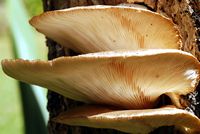
Owner: J.A. Cooper | 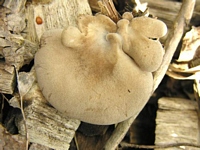
Caption: collection BD77, on wood chip mulch
Owner: B. Dee | 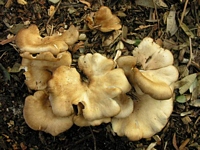
Caption: collection BD77, on wood chip mulch
Owner: B. Dee | 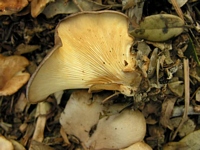
Caption: collection BD77, on wood chip mulch
Owner: B. Dee | 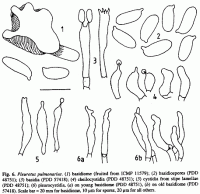 |
Article: Segedin, B.P.; Buchanan, P.K.; Wilkie, J.P. (1995). Studies in the Agaricales of New Zealand: new species, new records and renamed species of Pleurotus (Pleurotaceae). Australian Systematic Botany 8: 453-482.
Description: Pileus 60 x 90 mm in dried state, considerably larger when fresh, very pale fawn, smooth, dry, with no scurfy material near attachment as in P. opuntiae, margin inrolled at first but becoming straight to uplifted. In cultivated basidiomes, pileus 25-120 mm in diameter, almost white to greyish with pale grey, innate fibrils, smooth, dry; margin inrolled at first, becoming straight and slightly lobed. Lamellae decurrent, crowded, in five series, intervenose towards base of stipe, fairly broad (up to 5 mm in dried state) but not very thick, white to pale cream (cultivated basidiomes), drying ivory (PDD 57418) or ochraceous (PDD 48751, older specimen); margin smooth; face appearing velvety under X40 magnification. Stipe subcentric (in cultivated basidiomes) or excentric but never completely lateral, short (15 X 12 mm dried, 5-25 X 12 mm fresh cultivated), hirsute to long strigose especially in some basidiomes, the hairs fairly stout and white. Some suggestion of a ring on stipe in one fresh cultivated basidiome. Flesh white, thick (3-7 mm), soft and punky. Smell and taste unknown. Spore print white becoming pale cream.
Spores 8.5-11 X 3.5-5 (9.75 X 4.5) µm, Q = 2.1, variable in size, oblong elliptical to cylindrical, hyaline, not dextrinoid or amyloid, smooth, with a distinct, fairly broad apiculus. Basidia 30-50 X 6-7 µm, clavate, 2-4 spored, clamped at base. Cheilocystidia 14-25 X 7-8 µm, cylindrical to typically clavate, smooth, some with mucronate apex, small capitellum and mucus droplet, clamped at base, in a thick layer. Pleurocystidia common in some young basidiomes, 25-40 X 5-9 µm, fusiform to clavate, in clusters, sometimes with branching, apical prolongations (? the 'pegs' of Hilber 1982), probably overgrown by elongating basidia in older basidiomes, also seen on stipe lamellae. Also on lamellar face may be found some elongate cells, about twice length of basidia, clavate, thin-walled, collapsing easily, probably responsible for fine-velvety appearance as seen under a lens. Subhymenium narrow (up to 20 µm wide), cellular, the hyphae 2-4 µm in diameter. Trama of sclerified, generative hyphae of uniform diameter (4-6 µm), fairly loosely woven, irregular, but with a tendency towards radial growth, especially towards margin; no oleiferous hyphae seen. Context a very loose network of thick-walled generative hyphae 5-8 µm in diameter, with some sclerified tapering ends. Oleiferous hyphae fairly numerous, but contents not conspicuously yellow in KOH. Pileipellis not highly differentiated, with hyphae more or less parallel, slightly narrower and thinner-walled than in context, scarcely coloured, the contents with refractive dots. Stipe of some thin and some very thick-walled generative hyphae. Strigose hairs composed of bundles of narrow, clamped hyaline hyphae, uniformly 4 µm in diameter, fairly strongly agglutinated, with minute oil droplets in cytoplasm when young.
Habitat: On introduced hosts. Cassia corymbosa Lamarck cv. John Ball and Acacia
sp., in suburban gardens, and on native Cordyline australis.
|